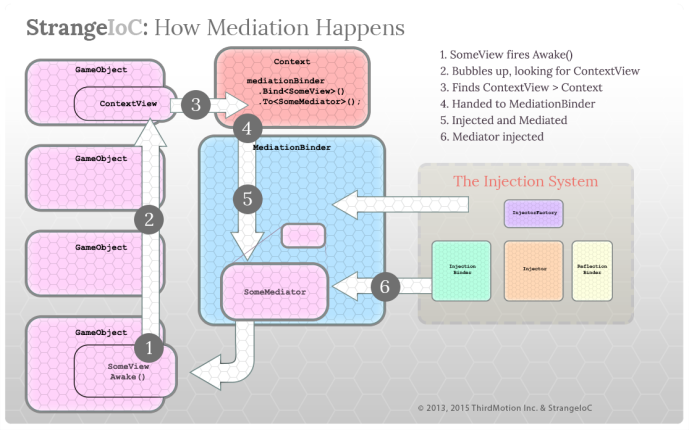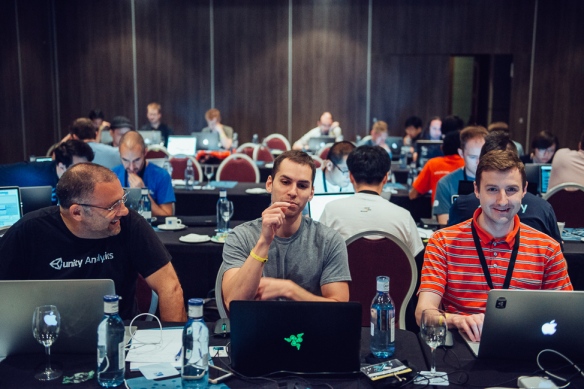These are my ideas so far around Best Practices for the v1.0 of the Big, Strange, How-To. Let me know what else we might want to say. What have I forgotten? What am I dead wrong about? Let’s work up a great list to help users get Stranger than ever.

My idea of a Strange Best Practice.
General
“Render unto Unity that which is Unity’s”
What is the core purpose of Strange?
Dependency injection? That’s just one of many features. Decoupling? That’s simply a means to an end. No, the core purpose of Strange is to make your life easier. It’s a tool, like any tool. And like any tool it should be applied to the correct set of jobs. However much you like drills, you wouldn’t drive a nail with one. In the end, all the DI/IoC/Decoupling magic has to be judged against that standard. So after giving it a reasonable try, consider every recommendation, “rule”, and philosophical tenet here by evaluating exactly that. I already know the extreme value of what I’m advocating. It won’t hurt my feelings if you disagree (well, maybe a little).
Does the feature you’re working on fit well into Strange’s structure? If you’re trying to rethink physics into a Strange controller because that’s “proper” MVC, then I guarantee you’re doing it wrong. Unity already has a very nice physics system. Let it do its job. A third-party AI designed to be attached to a specific GameObject is more of a grey area. So ask yourself: is this likely to change? Is there a sensible way to decouple (perhaps apply the AI MonoBehaviour as a secondary Mediator)? If you can do these things, make it Strange. If you can’t, you have my permission to let it be.
Injection
Minimize injection at performance-critical moments
Strange is at its best for application-level architecture, and at its worst in your game loop. Supplying Mediators and injections to thousands of enemies at a performance critical moment would not be a very efficient use of resources. Be realistic about your performance requirements. If your game is entirely turn-based, maybe the performance issue is irrelevant to you. If you’re trying to create a massively multiplayer action game that runs on an older smartphone, make sure you think this through!
Wrap a third-party Singleton
Lots of very fine (and some not so fine) third-party libraries are written as Singletons. While we disagree with this choice architecturally, it’s a simple fact of the Unity world. If you need to use a third-party library written as a Singleton, simply wrap it in an interface that is useful to you. We provide instructions on exactly how to do this in the injection deep dive.
If you need named bindings, use supply-binding where possible.
As of v1.0, you can apply named bindings through inversion.
Signals/Commands
Models and services should never listen to Signals
When models and services listen to Signals, they make two critical errors. First, they become tightly coupled to the rules of the specific game/application, which limits portability. Second, they bypass Commands, which tends to result in models and services bloated with logic. Logic is for Commands. Models handle state. Services communicate outside the app.
Dispatching Signals (as opposed to listening) is a bit more of a gray area. It still limits portability, but there’s less of a tendency to bypass Command logic. Stylistically, some people prefer to make Commands completely stateless, so that they are never retained. I prefer the following pattern.
Use Promises in retained Commands
The most common reason for retaining a Command is that you are calling outside Unity, waiting for some response. The new Promises package makes this sort of callback much cleaner and lowers the number of dependencies. It also strengthens the argument for keeping Signals out of services and models altogether.
Consider the following Command:
public class FetchLevelNameCommand : Command
{
[Inject]
public IServerAPI service { get; set;}
override public void Execute()
{
Retain();
service.FetchLevelName().Then(OnName);
}
private void OnName(string name)
{
//Do something with the result
Release();
}
}
What I like about this pattern is (a) it’s very clean, readable code, (b) your service needs no injected Signals, (c) any adapter logic (up, down, or both) gets handled in the same place.
Using clear naming conventions, match Signal names to Commands
Ideally, Signals and Commands should be named such that they obviously connect. Obviously, the entire point of decoupling them is to allow you not to do this. That doesn’t mean you need to set out to make things any harder than they have to be. Start things in alignment, and don’t lose sleep when design changes dictate that they drift.
Pool Commands when possible
Every object created and destroyed must be handled by garbage collection. Marking Commands as Pooled() eliminates some of this collection. Provided you are careful to clean up after yourself, it’s usually best to mark Commands this way. See the section on Command pooling for details.
Follow the single-responsibility principle in your Commands
Treat each Command like a method that does one thing. If a single Signal results in ten different things happening, ganging all that up into one Command makes that code complicated, non-portable and inflexible. On the other hand, if you break all those responsibilities down, it becomes much easier to reuse the bits that may apply to other Signals. You’ll get less code duplication and more reuse, and other programmers (including you in three months’ time) will be able to understand with greater ease what the hell you were trying to accomplish.
Avoid injecting into Views
This is definitely a best practice, not a requirement. When a View goes through the mediation process we explicitly check whether it needs injection. So why tell you not to do a thing that we explicitly allow and provide a mechanism for? This goes to a philosophy that I call “I’m not your mother”.
There are plausible reasons for injecting directly into Views: you might have a bit of decoupled code you want accessible by the View; you might not buy our argument about the value of mediation; perhaps you want to couple a model directly to a View for convenience. I might disagree with these choices (or maybe not, depending on circumstance), but the choice on how to use our tool is ultimately yours.
Now, why is it “best” not to do this? Read the mediation section in the deep dive: keeping your Views as pure Unity probably serves you best most of the time.
“Gang up” a View into a useful component
We often observe that new users misconstrue the purpose of mediation, thinking that each GameObject, each button, each line of text must be its own View with a corresponding Mediator. This is manifestly incorrect. The point of mediation is to allow you a clean separation between the View and the app…nothing in that specifies a 1:1 control:View relationship. Create useful components, small or large, that meet your needs, and mediate those. With UI, I often find that this correlates to 1 screen = 1 View.
Keep Mediators thin
Mediators aren’t intended to do the work of the View. Nor are they intended to provide (much) logic. The sole role of the Mediator is to adapt between View and application. Keep it thin.
Consider using multiple Mediators
It is commonly assumed that each View needs only one Mediator. This is usually sufficient, but there are excellent cases for applying multiple Mediators. My favorite is for analytics. Rather than mixing up your analytics logic (was this button clicked? how many times? before or after the user did this other thing?) with either View or Mediator, consider adding an extra Mediator solely for the purpose of listening out for button clicks and the like. This can make the agonizing process of instrumenting your game clean and trivial.
Contexts
Use clear naming conventions plus implicit bindings to keep Contexts clean
In even a moderately complex application, your Context can start to look like a very long shopping list. We find that many bindings start to crystallize as development proceeds. Rather than enumerate the blindingly obvious, we recommend using Strange’s implicit binding feature to keep your Context spare. Implicit bindings are always overridden by explicit bindings, so you can make changes when special cases arise.
Part of the trick to keeping this easy, especially in large teams, is to maintain sensible naming conventions so you can intuit the most likely implementing class.
//Sensible naming convention
public class PlayerModel : IPlayerModel
//Less sensible naming convention
public class PlayerModel : IPlayer
//Full-on insanity naming convention
public class DefaultPlayerModel : IShip
Build platform variants at the Class level; put all platform-dependent statements in the Context
Have you ever waded through code like this?
public class FaceRegognizer {
void Start () {
#if UNITY_EDITOR
Debug.Log("Doing a thing in Unity Editor");
#elif UNITY_IPHONE
Debug.Log("Doing a thing on Iphone");
#elif UNITY_STANDALONE_OSX
Debug.Log("Doing a thing on Stand Alone OSX");
#else UNITY_STANDALONE_WIN
Debug.Log("Doing a thing on Stand Alone Windows");
#endif
}
}
And let’s be honest: it’s NEVER that clean. Instead of having this code mixed-in and littered throughout your code, we recommend sectioning off all platform-specific behavior into well-named classes. You’ll still have all that #if…#elif magic, but it’ll all be in one place, and each implementing class will tell a consistent, readable story for its use case.
//All common capabilities in an abstract class
abstract public class AbstractFaceRecognizer : IFaceRecognizer{}
//Each of these implements the functionality as required by the platform
public class DefaultFaceRecognizer : AbstractFaceRecognizer{}
public class IosFaceRecognizer : AbstractFaceRecognizer{}
public class WindowsFaceRecognizer : AbstractFaceRecognizer{}
public class OSXFaceRecognizer : AbstractFaceRecognizer{}
//Now bind with all the #iffyness
#if UNITY_EDITOR
injectionBinder.Bind<IFaceRecognizer>().To<DefaultFaceRecognizer>().ToSingleton();
#elif UNITY_IPHONE
injectionBinder.Bind<IFaceRecognizer>().To<IosFaceRecognizer>().ToSingleton();
#elif UNITY_STANDALONE_OSX
injectionBinder.Bind<IFaceRecognizer>().To<OSXFaceRecognizer>().ToSingleton();
#else UNITY_STANDALONE_WIN
injectionBinder.Bind<IFaceRecognizer>().To<WindowsFaceRecognizer>().ToSingleton();
#endif
Stick to a strict, Context-based hierarchy
As we explained in the Mediation deep-dive, the Context-based hierarchy — i.e., childing a GameObject to a chain that can “bubble up” to a ContextView — is only required in a multi-Context situation. That said, starting this way, even in a single-Context situation, gives you the flexibility to choose the multi-Context approach at a later time.
Build modularity using multiple scenes, each in its own Context
One of Strange’s superpowers is connecting multiple Contexts. We often talk about it as a special use-case, but the utility of this concept shouldn’t be underestimated, especially when working in teams. This basically brings decoupling to the macro level, since one person/team can work on one chunk of a game, completely abstracted from others. A scene can be a mini-game, level, store, UI screen, what-have-you, built to stand all on its own, yet able to be integrated into the larger whole when necessary. This can greatly speed up workflow and even make it possible to share whole sections of a project between multiple games. I mean, seriously, once you’ve created an in-game store for Age of Jellyfish, do you really want to build it again for Age of Anchovies?
 Will Corwin just pulled us over the finish line! Or the starting line…whatever. The first release candidate for Strange v1.0 is now on tip.
Will Corwin just pulled us over the finish line! Or the starting line…whatever. The first release candidate for Strange v1.0 is now on tip.






 Will Corwin strikes again, offering a powerful new feature to the Strange feature set. This time, we introduce ‘Promises’, a simple, powerful pattern for handling asynchronous callback behavior. If you’re familiar with
Will Corwin strikes again, offering a powerful new feature to the Strange feature set. This time, we introduce ‘Promises’, a simple, powerful pattern for handling asynchronous callback behavior. If you’re familiar with